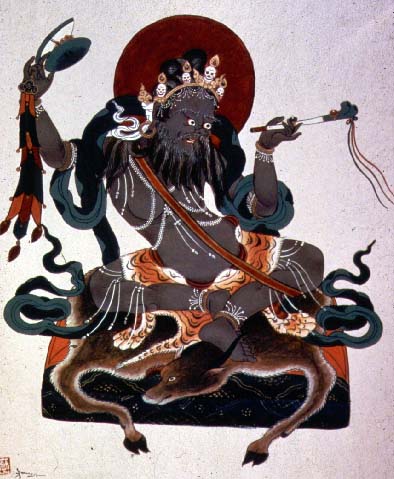
Padampa Sang-gyé
the sang-yab of Ma-gÇig Labdrön
Padampa Sang-gyé (rGya gar dam pa sangs rGyas) was the sang-yab (gSang yab) of Ma-gÇig Labdrön (ma gCig lab sGron, 1031-1126) and the father of gÇod, which literally means cutting. gÇod is a practice which unites the teachings of Prajnaparamita and the Mahayoga Tantras. gÇod was first propounded by the mahasiddha Padampa Sang-gyé and the Tibetan female mahasiddha Ma-gÇig Labdrön. Their tradition, called Zhi-jé (zhi byed), was one of the Eight Major Practice Lineages of Buddhism in Tibet.
Khandro Déchen says of this image:
Padampa Sang-gyé visited Tibet on several occasions during the 12th
century. This image shows him as an Indian mahasiddha
in the classical style. The unusual colour of his body is the combination of a
dark skin dusted with cremation ash. The ash is also matted with his beard and
hair. It is interesting to note that at this time Vajrayana was lived overtly
rather than expressed symbolically.
When practitioners of the
gö-kar chang-lo’i dé (gos dKar lCang loi sDe) practised during the 12th century—and before—they would wear the actual ornaments of the yidam as much as was feasible within the sadhana (drpthab sGrub thab). Here, Padampa Sang-gyé wears the
gomtag – meditation strap of the naljorpa / naljorma tradition and the five skull crown of the tantrika. He sits on the yogic deer skin mat and wears the cemetery ornaments (ru rGyan). He carries the implements of gÇod – the kangling (rKang gLing – human femur trumpet) and skull damaru (thod rgna). His eyes are wide open in the characteristic Dzogchen gaze. Ngak’chang Rinpoche spent some time wandering in the wilds of Chamba practising gÇod – wandering in areas which are no longer accessible. Chamba is a mountainous area beyond Triund, the highest point above McLeod Ganj, in Himachal Pradesh. Ngak’chang Rinpoche learnt gÇod from Lama Yeshé Dorje Rinpoche and practised
the gTröma gÇod a great deal when he was young. He was given his first kangling by Khandro Tendzin Drölkar – the wife of Lama
Yeshé Dorje Rinpoche as an inspiration. He later gave this
kangling to me when he was given another by Kyabjé Künzang Dorje Rinpoche.
Padampa Sang-gyé was an incarnation of Padmasambhava – as Ma-gÇig Labdrön was an incarnation of Yeshé Tsogyel. Married Lamas of the Nyingma tradition are always regarded by their disciples as manifestations of Padmasambhava and Yeshé Tsogyel. Together they replicated the dynamism of the first spread of the teachings in Tibet – and as such the teachings of gÇod have proliferated and been absorbed into every school, tradition, and lineage of Buddhism. Guru Chöwang (gu ru chos dBang, 1212-1270) and Jomo Menmo (jo mo men mo, 1248-1283) were the incarnations of Padampa Sang-gyé and Ma-gÇig Labdrön (and in turn incarnations of Padmasambhava and Yeshé Tsogyel).
Ngak’chang Rinpoche has received teachings of gÇod from the Düdjom gTér, Longchen Nying-thig, Chang gTér, and Khordong gTér systems of the Nyingma tradition, as well as from Kagyüd, and Sakya Schools. The actual tradition of Zhi-jé is no longer extant but it lives on within every yogic lineage. In the Aro gTér lineage the practices of sang gÇod and yang-sang gÇod (gSang gCod and yang gSang gCod), that is, secret gÇod and ultimate gÇod, are employed – but the outer and inner liturgical forms do not form part of the gTérma system.
